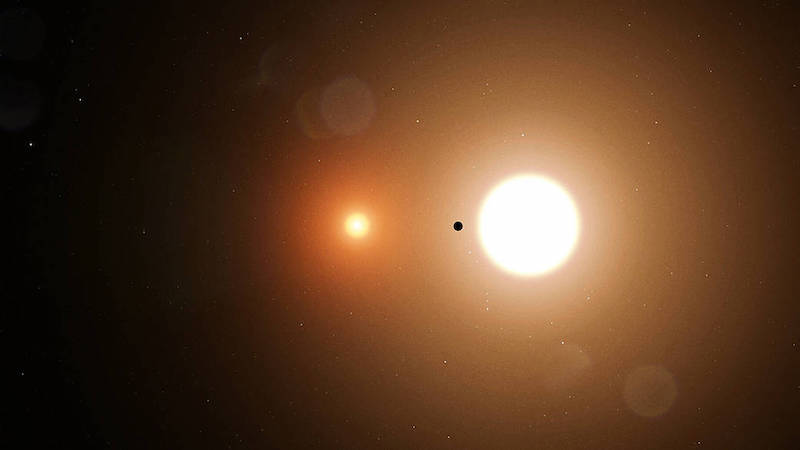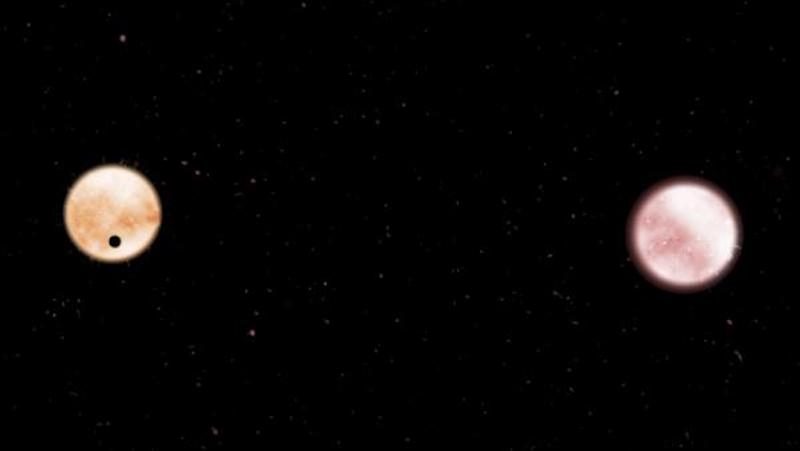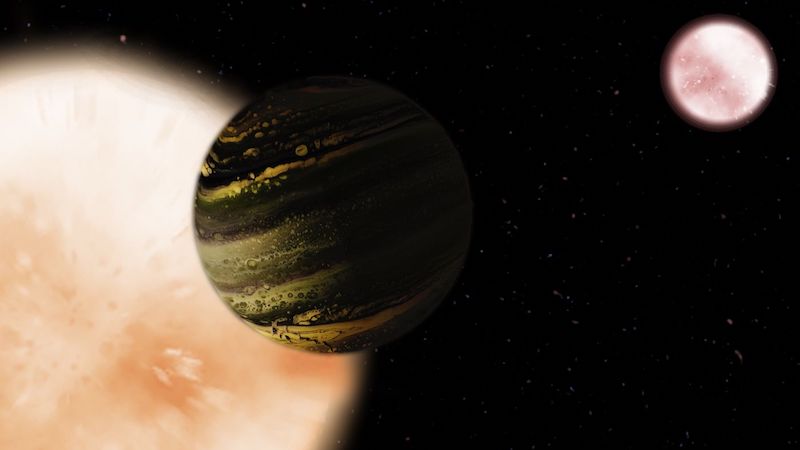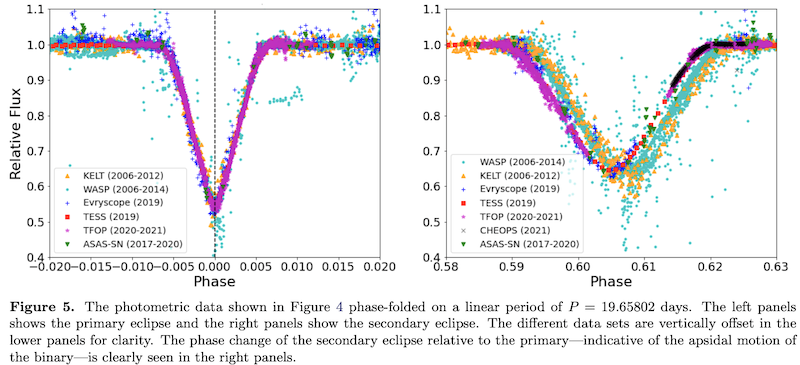
TESS’s planet orbiting 2 stars
Astronomers announced this month (November 10, 2021) that the space-based TESS planet-hunter (Transiting Exoplanet Survey Satellite) has discovered its first exoplanet orbiting two stars. Such planets are said to be circumbinary worlds. The newly found planet is a gas giant, almost exactly the same size as our solar system’s biggest world, Jupiter. But it’s about three times more massive than Jupiter. And it’s 818 light-years from Earth, in contrast to Jupiter’s distance of less than a light-hour.
The newly found planet is called TIC 172900988b. It orbits its dual host stars in only 200.5 Earth-days (Jupiter takes 12 Earth-years to orbit our sun once). The discovery is significant to scientists because it demonstrated it was possible to detect TIC 172900988b with a limited amount of data. The scientists observed as the planet transited its primary star, then transited its secondary star five days later. The two stars underwent an eclipse of each other, too, over a 20-day orbit. The scientists said in a statement:
Previous detections of circumbinary planets required observing three transits which was not possible in the short observation window.
To put all this into some context, check out the cool tweet below from Vivien Parmentier, from November 10. He’s not associated with this discovery. But he is a physicist interested in exoplanets at Somerville College in England. NOTE added after publication: JPL announced on December 22, 2021 that a deep learning method has added another 301 new exoplanets – in addition to the ones mentioned in the tweet below – to the total count.
How it started/ how it's going #exoplanets pic.twitter.com/zhU3AdhKYR
— Vivien Parmentier (@V_Parmentier) November 10, 2021
Shades of Tatooine
Of course, the discovery of TIC 172900988b is significant to sci-fi fans, too. It’s reminiscent of the classic (and thoroughly shocking, at the time) first view of Tatooine, the fictional planet with two suns first glimpsed in the 1977 film Star Wars: Episode IV – A New Hope .
Now, astronomers are finding real-life exoplanets that really do orbit two stars. So far, astronomers using the latest observing tools have found 14 circumbinary planetary systems.
A first for TESS
TIC 172900988b is a first for TESS, which was launched in April 2018 aboard a SpaceX Falcon 9 rocket. The primary mission phase for TESS ended in April 2020, after the satellite had detected some 2,600+ exoplanets. The discovery of a circumbinary planet by TESS shows this planet-hunter still has more worlds to find!
The TESS discovery involves a new technique developed in part by scientists from the Planetary Science Institute, a nonprofit organization founded in 1972, based in Tucson, Arizona, and dedicated to solar system exploration. Veselin B. Kostov of the SETI Institute – a research-based nonprofit, based in Mountain View, California – led the new study.
The Astronomical Journal published a new peer-reviewed paper detailing the discovery on November 10. It is also available as a preprint.


TESS’s planet orbiting 2 stars
So this new planet is the TESS planet-hunter’s first circumbinary world. During its primary mission phase, TESS divided the sky into 26 “sectors” (13 in the Northern Hemisphere and 13 in the Southern Hemisphere). The satellite is in a highly elliptical 13.7-day orbit around Earth. So it observed each sector for two Earth-orbits, or about 27 days, each to observe the entire sky.
TESS observed the new circumbinary planet in a single sector (Sector 21). Upon analysis, scientists could see that the light curve showed two transits of the planet, one in front of each star, during the same conjunction. Kostov stated:
The occurrence of multiple closely-spaced transits during one orbit is a unique observation signature of transiting circumbinary planets. This is a geometrical phenomenon that provides a new planet detection method. The discovery of TIC 172900988b is the first demonstration that the method works.
Nader Haghighipour of the Planetary Science Institute echoed that statement, saying:
Our group was able to show that despite its short window of observation, it is still possible to use TESS to detect circumbinary planets. The new planet is the proof of the validity, applicability and success of our invented technique. This discovery demonstrates that our new technique works and will be able to find many more planets.

A new technique to discover circumbinary planets
The most common method for finding circumbinary planets is transit photometry. It measures how much a star dims when a planet transits in front of it, as seen from Earth. At least three transits are required to determine the orbit of a planet. But this observation isn’t as easy in a double-star system, because the transits will occur at different intervals over the same star. As Haghighipour explained:
Detecting circumbinary planets is much more complicated than detecting planets orbiting single stars. The most promising technique for detecting circumbinary planets is transit photometry, which measures drops in starlight caused by those planets whose orbits are oriented in space such that they periodically pass between their stars and the telescope. In this technique, the measurements of the decrease in the intensity of the light of a star is used to infer the existence of a planet.
To precisely determine the orbit of the planet, at least three transit events are required. This becomes complicated when a planet orbits a double-star system because transits will not happen with same interval over the same star. The planet may transit one star and then transit the other before transiting the first star again, and so on.
Only two transits needed
Unlike its predecessor, Kepler, TESS isn’t really suited for finding circumbinary planets. This is due to the fact that to catch such transits, the telescope must observe the binary star system for a long time. Those transits take longer to monitor since the orbital period of the planets are significantly longer than for single stars. And TESS observes one part of the sky for only 27 days, before moving to the next one.
So, normally, TESS can see only two transits at the most, not three. But now, with the new technique, astronomers say they can determine the existence of the planet(s) with only two transits.
TESS’s primary mission ended on July 4, 2020, and it is now in an extended mission phase. It continues to find widely diverse planets, ranging from small, rocky worlds to giant planets.

Bottom line: NASA’s TESS mission has just found its first planet orbiting two stars – a Jupiter-sized world – using a newly-developed technique for detecting circumbinary planets.
Source: TIC 172900988: A Transiting Circumbinary Planet Detected in One Sector of TESS Data











